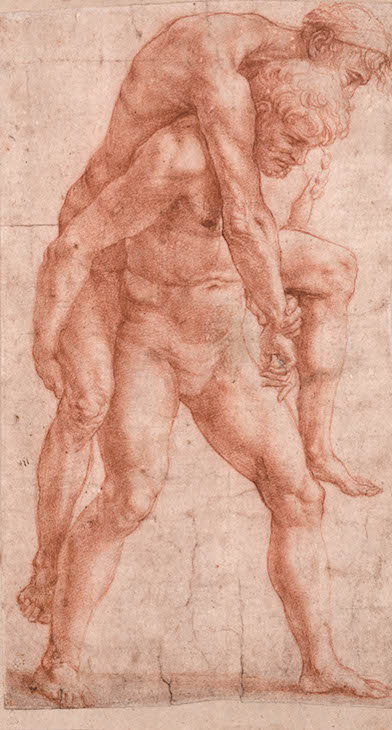‘Raphael: The Drawings’
1 June–3 September 2017
The Ashmolean, Oxford
View the shortlist
The no-nonsense directness of the Ashmolean’s title suggested from the outset that the exhibition’s focus would be on Raphael’s drawings, and it delivered on that through the sheer quality and variety of the 120 sheets on view. The two main curators Catherine Whistler and Ben Thomas were able to chart Raphael’s rapid development as a draughtsman from the late 1490s until his premature death in 1520 in such depth thanks to the Ashmolean’s superb Raphael holdings, the majority rescued from the break-up of Sir Thomas Lawrence’s collection in 1830. To this they added loans from all the major repositories of the artist’s graphic works so that notable groups documenting the formulation of the artist’s major projects, such as the frescoed decoration of the Pope’s library in the Vatican Palace, were included (a version of the exhibition travelled to the Albertina in Vienna in September).
A man carrying an older man on his back (c. 1513–14), Raphael (1483–1520). Albertina Museum, Vienna. Photo: © Albertina Museum, Vienna

The curators innovatively explored the drawings by looking at them through the prism of Renaissance theories of eloquence, which was appropriate in view of Raphael’s courtly upbringing in Urbino, as well as the emotive power of his art that was so instrumental in making him the model for European artists until the beginning of the last century. This approach also shifted attention towards the ways in which Raphael heightened the affective force of his compositions and individual figures on paper, rather than focusing on drawing as a preparatory stage in the development of the finished work. The result was an exhibition that brought the force of Raphael’s creative intelligence thrillingly to life as he explored and honed his ideas on paper. The rapt attention of the visitors that I witnessed on my visits to the show, as well as the crowds in attendance, amply testifies to the spell that Raphael’s drawings continue to cast.
Hugo Chapman
 The Winners | Personality of the Year | Artist of the Year | Museum Opening of the Year | Exhibition of the Year | Book of the Year | Digital Innovation of the Year | Acquisition of the Year | View the shortlists
The Winners | Personality of the Year | Artist of the Year | Museum Opening of the Year | Exhibition of the Year | Book of the Year | Digital Innovation of the Year | Acquisition of the Year | View the shortlists



